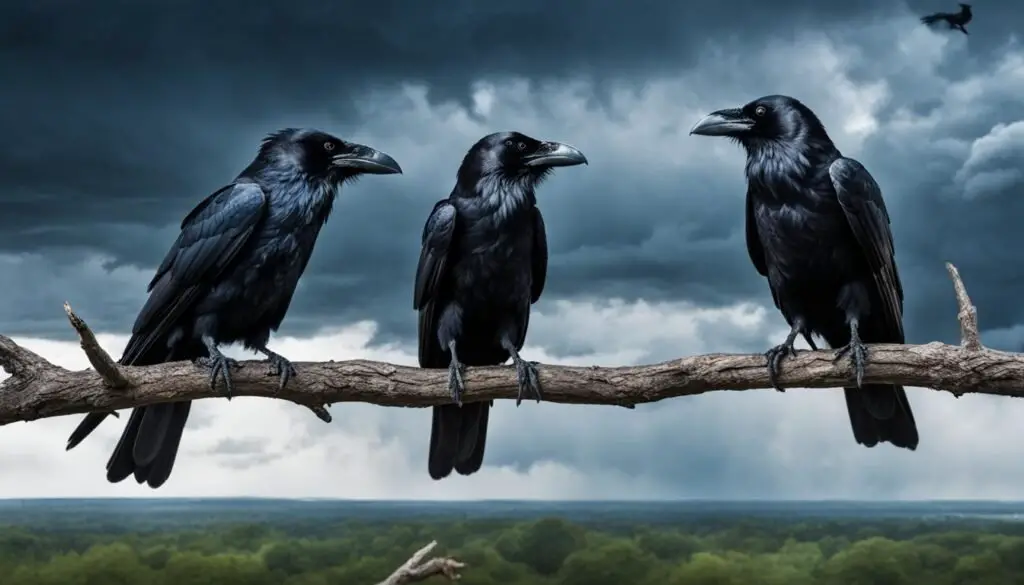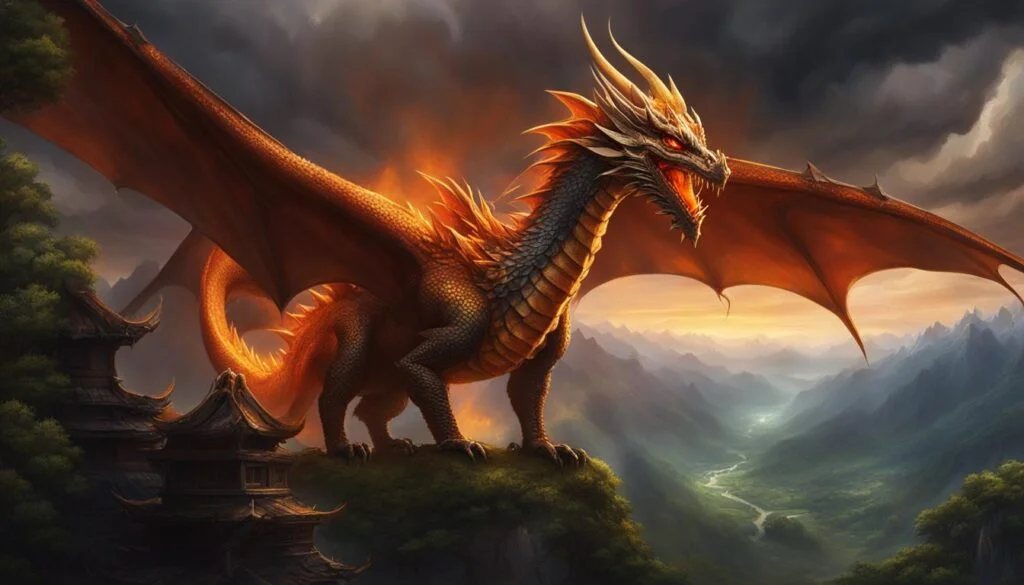In Norse mythology, ravens hold a special place as powerful symbols. Odin, the chief god of the Norse pantheon, had two ravens, Huginn and Muninn, who flew all over the world and brought him information about everything that was happening. The symbolism of the raven in Norse mythology is complex and multifaceted, and it has been the subject of much discussion and debate among scholars and enthusiasts alike.
Key Takeaways:
- Ravens in Norse mythology symbolize wisdom, knowledge, power, and magic.
- They are associated with death and the underworld and are closely linked to Odin, the god of war, wisdom, and magic.
- Huginn and Muninn, Odin’s ravens, served as his messengers, gathering information and providing him with advice.
- Ravens are also important in Celtic mythology, representing magic, prophecy, and transformation.
- The white raven is a rare and powerful symbol, associated with prophecy and the ability to see into the future.
Animals and their Symbolism in Norse Culture and Mythology
Animals have always held great significance in Norse culture and mythology. They were seen as more than just creatures; they were symbols that represented various qualities and characteristics.
One of the most revered animals in Norse mythology is the raven. Known for their intelligence and connection to Odin, the chief god of the Norse pantheon, ravens were highly regarded for their mystical qualities.
In addition to ravens, wolves, bears, horses, snakes, and dragons were also significant animals in Norse mythology. Each of these animals was associated with specific traits and attributes that held important meaning in Norse beliefs.
Wolves, for example, symbolized strength and protection, while bears represented courage and endurance. Horses were associated with luck and fertility, while snakes were seen as guardians of hidden knowledge. Dragons, on the other hand, symbolized power and wisdom.
These animals played important roles in Norse myths and legends, often serving as companions or adversaries to the gods and heroes. They embodied the values and qualities that were highly revered in Norse society.
To better understand the symbolism of animals in Norse mythology, let’s take a closer look at the significance of ravens in Norse culture.
The Significance of Ravens in Norse Culture and Mythology
Ravens held a special place in Norse culture and were regarded as creatures of great intelligence and wisdom. They were believed to possess magical powers and were seen as messengers between the gods and humans.
Odin, the Norse god of war, wisdom, and magic, had two ravens, Huginn and Muninn, who flew all over the world and brought him information about everything that transpired.
The presence of ravens was often seen as a sign that Odin was nearby or that he was observing the events taking place. Their ability to gather information and their deep connection to Odin made ravens highly revered creatures in Norse mythology.
Ravens also symbolized death and the underworld, further emphasizing their importance in Norse beliefs. They were closely associated with Odin’s role as the god of the afterlife, guiding souls to the realm of the deceased.
As symbols of intelligence, knowledge, and supernatural power, ravens played a crucial role in Norse mythology, reflecting the values and beliefs of the ancient Norse culture.
- Ravens symbolized intelligence and wisdom.
- Ravens were associated with Odin, the chief god of the Norse pantheon.
- Ravens represented the connection between the mortal world and the divine.
- Ravens were messengers between the gods and humans.
- They symbolized death and the afterlife.
In the next section, we will delve deeper into the symbolism of ravens in Norse mythology and explore their specific roles in ancient Norse beliefs.
The Symbolism of Ravens in Norse Mythology
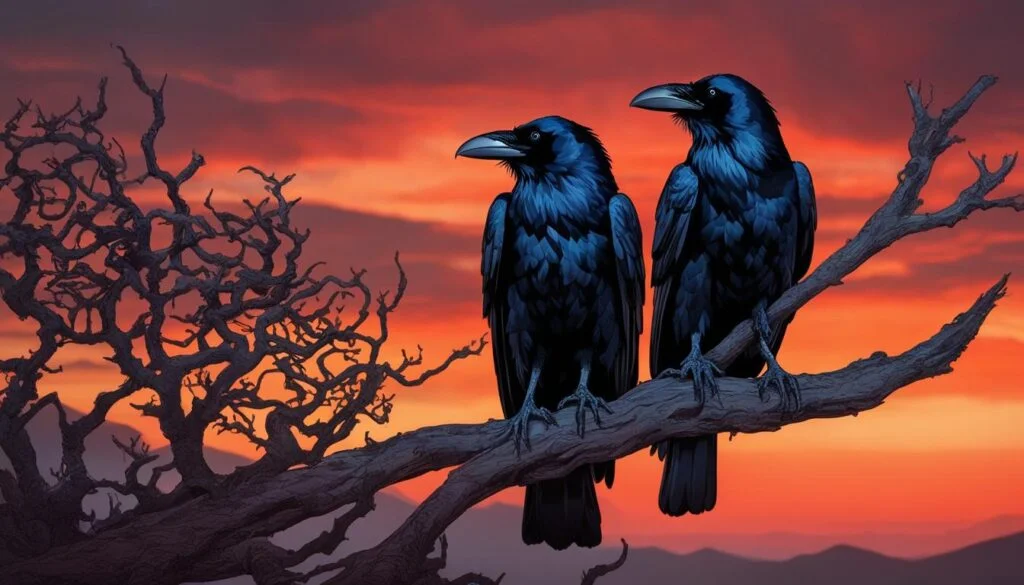
In Norse mythology, ravens hold significant symbolic meaning. They are associated with wisdom, knowledge, power, and magic. These majestic birds have a strong connection to Odin, the god of war, wisdom, and magic.
According to ancient lore, Odin had two ravens named Huginn and Muninn. These ravens would fly all over the world, observing and gathering information for Odin. They were considered his trusted messengers, bringing him valuable knowledge from every corner of existence.
The symbolism of ravens in Norse mythology is closely intertwined with their association with Odin. They embody intelligence and are symbolic of the search for knowledge and wisdom.
Ravens are also linked to the realm of death and the underworld in Norse mythology. They are often depicted as ominous birds, guiding souls to the afterlife and serving as a bridge between the mortal world and the supernatural.
As symbols of both life and death, ravens embody the duality of nature and the mysteries of the spiritual realm.
Throughout Norse mythology, ravens are revered for their intelligence and magical qualities. They are seen as mystical creatures with the ability to channel powerful forces and connect with the divine.
In modern popular culture, the symbolism of ravens in Norse mythology continues to captivate and inspire. Their representation as wise, enigmatic creatures remains a fascinating aspect of Norse folklore and mythology.
The Role of Huginn and Muninn in Norse Mythology
In Norse mythology, the two ravens, Huginn and Muninn, play crucial roles as Odin’s loyal messengers. Their names meaning “thought” and “memory” respectively, these intelligent and mystical birds were entrusted with the task of traversing the world to gather information and bring it back to Odin.
Huginn and Muninn were often depicted perching on Odin’s shoulders or soaring in circles around him, their dark feathers glistening in the sunlight. As messengers, they possessed not only the ability to observe and understand the world around them but also the gift of speech, enabling them to directly communicate with Odin.
These ravens served as Odin’s eyes and ears, providing him with valuable insight and advice. Through their ability to traverse great distances and perceive the hidden truths of the world, Huginn and Muninn became invaluable assets to the god of war, wisdom, and magic.
It is said that when Odin would send them off into the realms, he would whisper into their feathers, sharing his thoughts and desires, and in turn, they would return to whisper their findings and wisdom back to him. Their presence represented not only their important role as messengers but also embodied Odin’s connection to the supernatural and his unrivaled knowledge.
The significance of Huginn and Muninn in Norse mythology extends beyond their roles as mere messengers. They symbolize the power of thought, memory, and the pursuit of knowledge, exemplifying the values prized by the Norse people. The sight of these majestic birds soaring through the sky served as a reminder of the ancient wisdom and guidance offered by the gods.
Throughout history and in contemporary popular culture, the mystique and symbolism associated with Huginn and Muninn endure. These extraordinary creatures continue to captivate the imagination of many, reminding us of the profound wisdom and magic embedded in Norse mythology.
Raven Symbolism in Norse Runes
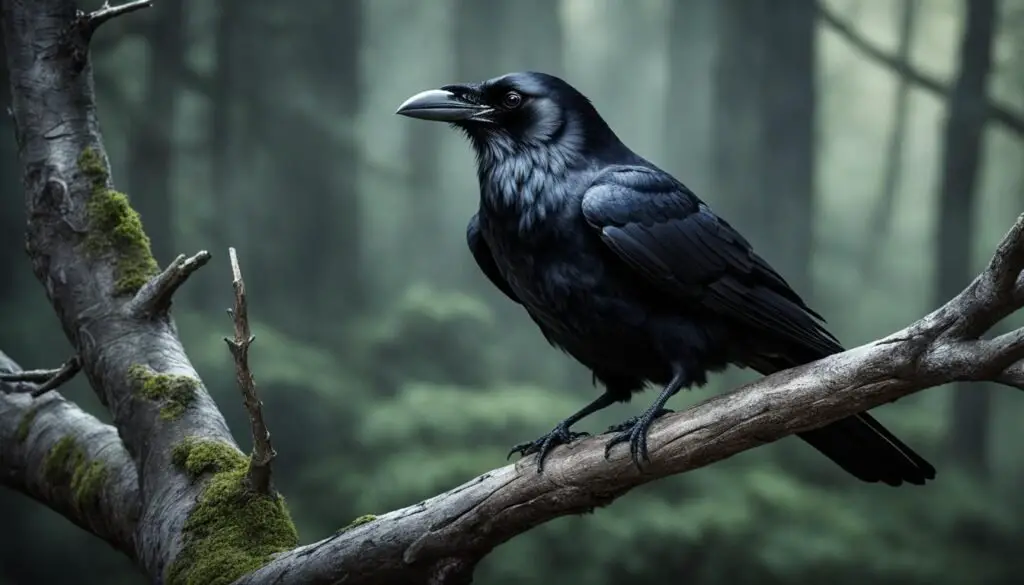
In Norse mythology, the raven rune, also known as the “fehu” rune, holds significant symbolic meaning in Norse runes. The ancient writing system of Norse culture, the runes, were used in various magical rituals and spells for different purposes, such as good luck, protection, and shape-shifting.
The raven rune specifically represented the qualities associated with ravens in Norse mythology, including wisdom, knowledge, power, and magic. This iconic symbol was revered for its connection to the mystical realm and its ability to tap into the supernatural forces believed to exist in the Norse world.
To visualize the raven rune and its representation, take a look at the image below:
The image showcases the raven rune itself, capturing its intricate design and the essence it carries within Norse mythology. As you can see, the rune bears resemblance to a raven, emphasizing its symbolism and association with these mystical creatures.
Significance of the Raven Rune
- Wisdom: The raven rune represents the wisdom and intelligence embodied by the raven in Norse mythology. It is a symbol of profound knowledge and understanding.
- Knowledge: Just like ravens were known for gathering information and sharing it with Odin, the raven rune signifies the acquisition and dissemination of knowledge.
- Power: In Norse culture, ravens were associated with power and dominance. The raven rune carries this symbolism, projecting strength and authority.
- Magic: Ravens had strong ties to magic and mystical abilities in Norse mythology. The raven rune taps into the same supernatural forces, signifying its connection to the realm of magic.
The inclusion of the raven rune in the Norse runic system emphasizes the pervasive influence of raven symbolism in ancient Norse beliefs and mythology. Its presence showcases the significance of ravens as powerful beings associated with wisdom and magic.
Wolf and Raven Meaning in Norse Mythology
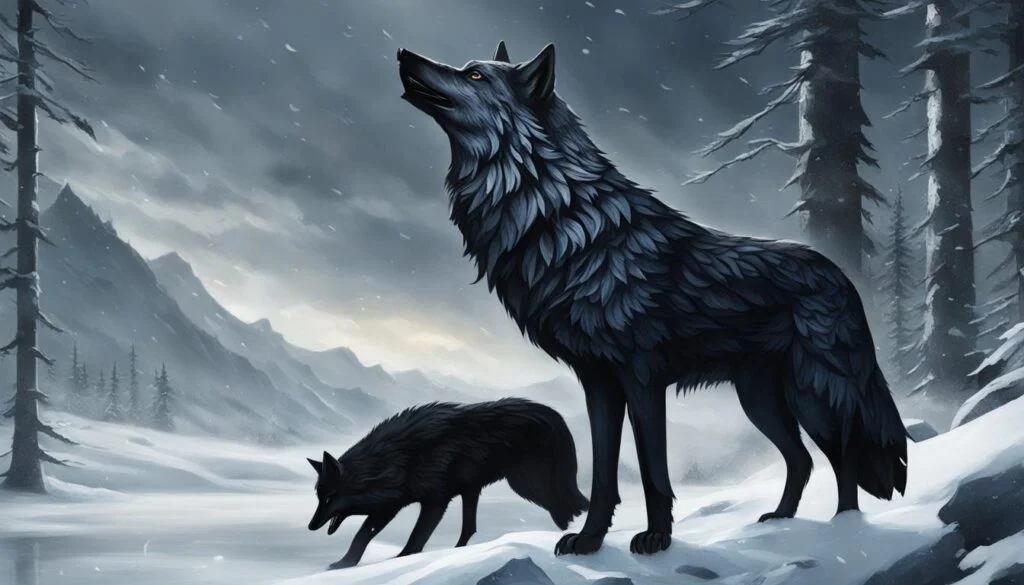
In Norse mythology, the wolf and the raven are often depicted together and associated with Odin. They embody the balance between wisdom and instinct, highlighting the duality of nature. The wolf symbolizes strength and protection, while the raven is linked to death and the afterlife. Together, they represent different aspects of Odin’s character as a wise strategist and a fierce warrior.
The wolf, a powerful creature, represents bravery, loyalty, and ferocity. It is revered for its strength and its role as a guardian. In Norse mythology, Odin was often accompanied by wolves, including his faithful companions, Geri and Freki. The wolf symbolizes the protective instincts needed in battle and highlights Odin’s role as a protector of his people.
On the other hand, the raven is associated with death, the afterlife, and the supernatural. It is believed to have a profound connection to the spirit world and possesses great wisdom and knowledge. The raven’s association with death reflects its role as an emissary between the realms of the living and the dead.
As a combination, the wolf and raven represent the harmony between wisdom and instinct, showcasing the multifaceted nature of Odin. The wolf provides strength and protection, while the raven brings wisdom and knowledge. Together, they form a powerful symbol that embodies the qualities and attributes Odin possesses as the chief god of the Norse pantheon.
Celtic Raven Meaning
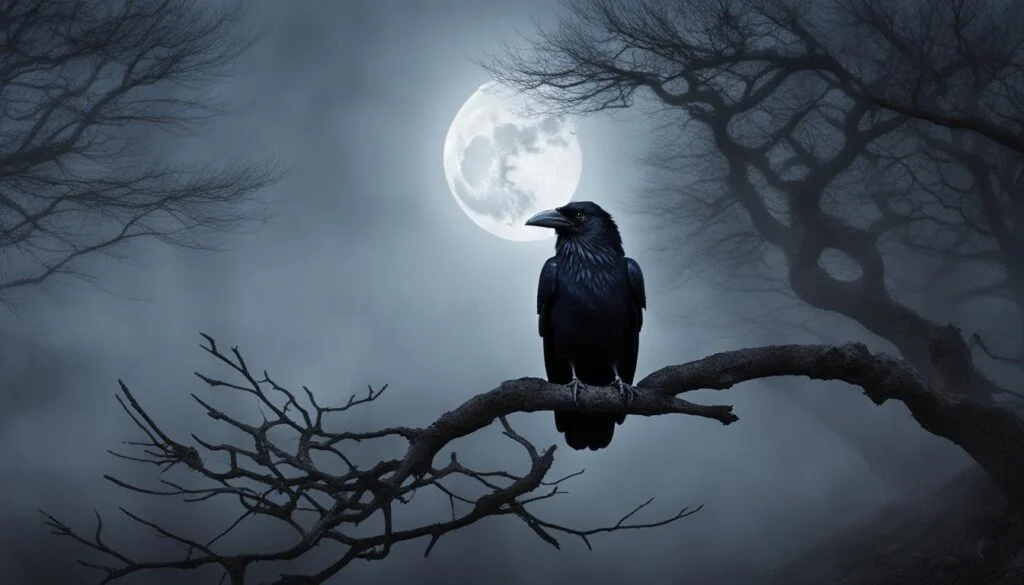
In Celtic mythology, ravens hold significant symbolic meaning, much like their counterparts in Norse mythology. They are associated with magic, prophecy, and transformation, embodying the mystical essence of the Celtic folklore and belief system.
Ravens were believed to possess the power of shape-shifting, allowing them to take on different forms and traverse both the physical and spiritual realms. This ability made them integral to magical rituals and spells performed by Celtic practitioners.
Moreover, ravens were revered as messengers between the living and the dead, acting as conduits between realms. They were believed to carry the souls of departed individuals to the Otherworld, the realm of the deceased in Celtic mythology.
Raven Symbolism in Celtic Culture
In Celtic culture, ravens symbolize wisdom, secret knowledge, and divine guidance. They are often associated with Celtic deities and have been depicted as companions to goddesses associated with war, magic, and fate.
Their presence signifies a connection to the supernatural and the ability to tap into higher realms of consciousness. Ravens are revered as guardians of ancient wisdom and revered for their extraordinary intelligence.
The Significance of Ravens in Celtic Folklore
Ravens feature prominently in Celtic folklore, captivating storytellers and enchanting listeners with their mythical qualities. These revered birds are often portrayed as enigmatic creatures capable of prophesying the future or delivering messages from the spirit world.
Their appearance in Celtic legends and tales serves as a reminder of the profound connection between the natural world and the mystical realm. Ravens command respect and convey a sense of mystery in Celtic folklore, embodying the elusive and unpredictable nature of magic and fate.
Whether it be their association with magic and prophecy or their role as messengers between realms, ravens hold a significant place in Celtic mythology, enriching the tapestry of legends and beliefs with their powerful symbolism.
White Raven Meaning in Norse Mythology
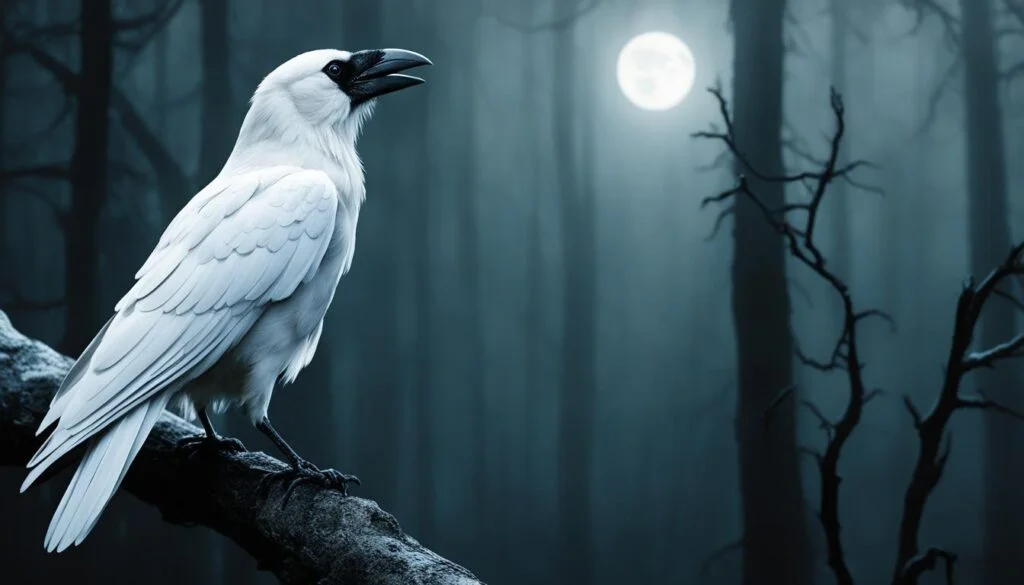
In Norse mythology, the white raven holds a special place as a rare and powerful symbol of prophecy and magic. Unlike its black counterparts, the appearance of a white raven is believed to be a significant omen, signaling the presence of individuals destined for greatness. These magnificent creatures bring messages of wisdom and guidance, leading those who encounter them on a path of enlightenment and fulfillment.
White ravens are also associated with clairvoyance and the ability to see into the future. Their pure white feathers are believed to possess mystical qualities that enable them to predict important events and provide insights into the unknown. This magical power and their exceptional rarity make white ravens highly respected and revered in Norse mythology.
The symbolism of white ravens in Norse mythology represents the extraordinary and the extraordinary abilities that exist within individuals. It serves as a reminder that greatness is not limited to appearances or predictable outcomes but can arise unexpectedly, guided by the wisdom carried by these mystical birds.
Conclusion
In Norse mythology, ravens hold profound symbolic meaning, representing wisdom, knowledge, power, and magic. They are closely associated with Odin, the chief god of the Norse pantheon, and his ravens, Huginn and Muninn, who served as messengers, providing him with valuable information from all corners of the world.
Ravens in Norse mythology are not only associated with Odin but also symbolize death and the afterlife. They embody the supernatural and the magical aspects of Norse culture, making them significant symbols in ancient Norse beliefs.
The symbolism of ravens in Norse mythology extends beyond the realm of mythology itself. Even in modern popular culture, ravens are revered for their intelligence and their connection to the mystical realm. Their importance and symbolism continue to captivate and inspire people, serving as a reminder of the rich and intriguing Norse folklore heritage.
FAQ
What is the significance of ravens in Norse mythology?
Ravens hold a special place in Norse mythology as powerful symbols. They are associated with wisdom, knowledge, power, and magic. Ravens also symbolize death and the underworld and are closely linked to Odin, the chief god of the Norse pantheon.
Who are Huginn and Muninn in Norse mythology?
Huginn and Muninn are two ravens who served as messengers to Odin. Their names mean “thought” and “memory” respectively. They flew all over the world, gathering information and bringing it back to Odin.
What is the symbolism of the raven rune in Norse mythology?
The raven rune, also known as the “fehu” rune, represents the qualities associated with ravens in Norse mythology, such as wisdom, knowledge, power, and magic. It was used in magical rituals and spells for good luck, protection, and shape-shifting.
What is the meaning of the wolf and raven symbolism in Norse mythology?
The wolf and raven are often depicted together in Norse mythology and are associated with Odin. They represent the balance between wisdom and instinct, as well as the duality of nature. The wolf symbolizes strength and protection, while the raven is associated with death and the afterlife.
What is the symbolism of ravens in Celtic mythology?
In Celtic mythology, ravens are associated with magic, prophecy, and transformation. They are believed to have the power to shape-shift and were often used in magical rituals and spells. Ravens are also seen as messengers between the living and the dead, carrying souls to the Otherworld.
What is the meaning of the white raven in Norse mythology?
The white raven is a rare and powerful symbol associated with prophecy and magic in Norse mythology. It is believed to appear to individuals destined for greatness, bringing messages of wisdom and guidance. The white raven is also associated with the ability to see into the future and predict important events.


